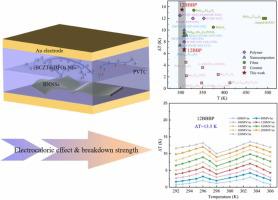当前位置:
X-MOL 学术
›
Nano Energy
›
论文详情
Our official English website, www.x-mol.net, welcomes your
feedback! (Note: you will need to create a separate account there.)
Giant electrocaloric effect and breakdown field strength in ferroelectric terpolymer nanocomposites by morphologically diverse nanostructures
Nano Energy ( IF 16.8 ) Pub Date : 2024-07-01 , DOI: 10.1016/j.nanoen.2024.109948 Min Zhao , Xiaofan Sun , Peiqi Ji , Tingfeng Li , Yanzhou Lu , Ligang Ma , Cuiping Xu , Shulin Jiao , Jiaqi Dai , Yizhang Wu , Hong-Ling Cai , X.S. Wu
Nano Energy ( IF 16.8 ) Pub Date : 2024-07-01 , DOI: 10.1016/j.nanoen.2024.109948 Min Zhao , Xiaofan Sun , Peiqi Ji , Tingfeng Li , Yanzhou Lu , Ligang Ma , Cuiping Xu , Shulin Jiao , Jiaqi Dai , Yizhang Wu , Hong-Ling Cai , X.S. Wu

|
Electrocaloric cooling is a method for flexible electronics and compact chips with a promising ability to subvert traditional vapor compression refrigeration technology. Nevertheless, most reported EC materials exhibit relatively low adiabatic temperature (ΔT) and low breakdown field strength (E b 0.2 Ti0.8 O3 )-0.32(Ba0.7 Ca0.3 TiO3 )] (BCZT), boron nitride nanosheets (BNNSs), and BiFeO3 nanofibers (BFO NFs) with different morphologies and vary components ratios. The most optimal 12BBBP nanocomposite demonstrates gigantic ECE values including an isothermal entropy change (ΔS) of 94.5 J·kg−1 ·K−1 and a ΔT of 13.5 K under 220 MV/m electric field at 303 K, ΔS and ΔT are 3.5 times and 2.2 times larger than PVTC under 100 MV/m. It also exhibits an excellent E b E b E b
中文翻译:

形态多样的纳米结构铁电三元聚合物纳米复合材料中的巨大电热效应和击穿场强
电热冷却是一种用于柔性电子设备和紧凑芯片的方法,有望颠覆传统的蒸汽压缩制冷技术。然而,大多数报道的EC材料在室温下表现出相对较低的绝热温度(ΔT)和较低的击穿场强(Eb),限制了它们的进一步应用。在这里,我们开发了一种铁电纳米复合材料,由弛豫三元共聚物聚(偏二氟乙烯-三氟乙烯-氯氟乙烯)(PVTC)、陶瓷纳米填料[0.68(BaZr0.2Ti0.8O3)-0.32(Ba0.7Ca0.3TiO3)](BCZT)组成,氮化硼纳米片(BNNS)和BiFeO3纳米纤维(BFO NF)具有不同的形貌和不同的成分比例。最优化的12BBBP纳米复合材料表现出巨大的ECE值,包括在303 K、220 MV/m电场下94.5 J·kg−1·K−1的等温熵变(ΔS)和13.5 K的ΔT,ΔS和ΔT为3.5 100 MV/m 下比 PVTC 大 2 倍和 2.2 倍。它还表现出出色的 Eb,值为 290 MV/m。相场模拟用于模拟不同纳米形貌填料的纳米复合材料在静电场下的 Eb 行为。同时,还通过有限元分析(FEA)基于瞬态Landau-Ginzburg-Devonshire(TLGD)理论模拟了界面耦合和铁电畴结构,以更好地解释ECE性能。实验和模拟结果同时表明铁电纳米复合材料具有优异的ECE和高Eb性能,为铁电材料在柔性电子和紧凑芯片冷却等领域的应用奠定了基础。 结合三元共聚物的易加工性和电活性陶瓷的无铅特性,这项工作为开发用于下一代制冷的可扩展、环保和高性能EC材料铺平了新的道路。
更新日期:2024-07-01
中文翻译:

形态多样的纳米结构铁电三元聚合物纳米复合材料中的巨大电热效应和击穿场强
电热冷却是一种用于柔性电子设备和紧凑芯片的方法,有望颠覆传统的蒸汽压缩制冷技术。然而,大多数报道的EC材料在室温下表现出相对较低的绝热温度(ΔT)和较低的击穿场强(Eb),限制了它们的进一步应用。在这里,我们开发了一种铁电纳米复合材料,由弛豫三元共聚物聚(偏二氟乙烯-三氟乙烯-氯氟乙烯)(PVTC)、陶瓷纳米填料[0.68(BaZr0.2Ti0.8O3)-0.32(Ba0.7Ca0.3TiO3)](BCZT)组成,氮化硼纳米片(BNNS)和BiFeO3纳米纤维(BFO NF)具有不同的形貌和不同的成分比例。最优化的12BBBP纳米复合材料表现出巨大的ECE值,包括在303 K、220 MV/m电场下94.5 J·kg−1·K−1的等温熵变(ΔS)和13.5 K的ΔT,ΔS和ΔT为3.5 100 MV/m 下比 PVTC 大 2 倍和 2.2 倍。它还表现出出色的 Eb,值为 290 MV/m。相场模拟用于模拟不同纳米形貌填料的纳米复合材料在静电场下的 Eb 行为。同时,还通过有限元分析(FEA)基于瞬态Landau-Ginzburg-Devonshire(TLGD)理论模拟了界面耦合和铁电畴结构,以更好地解释ECE性能。实验和模拟结果同时表明铁电纳米复合材料具有优异的ECE和高Eb性能,为铁电材料在柔性电子和紧凑芯片冷却等领域的应用奠定了基础。 结合三元共聚物的易加工性和电活性陶瓷的无铅特性,这项工作为开发用于下一代制冷的可扩展、环保和高性能EC材料铺平了新的道路。











































 京公网安备 11010802027423号
京公网安备 11010802027423号